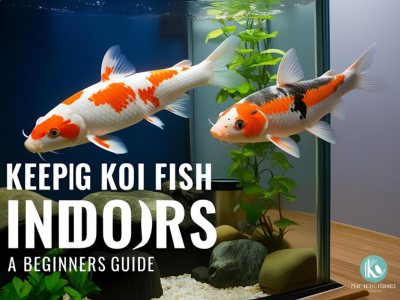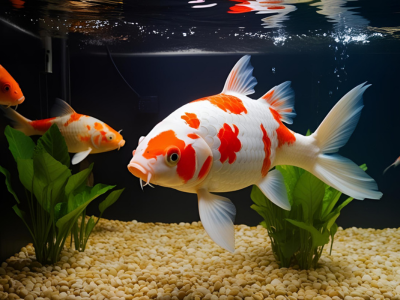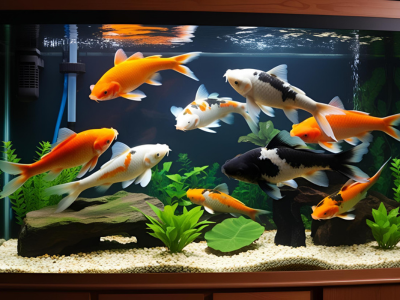Introduction
Koi fish are colorful and peaceful creatures that many people love to keep in ponds. But did you know you can also keep koi fish indoors? Having a koi fish tank inside your home can make your space feel peaceful, beautiful, and full of life. Watching koi swim gracefully is very calming and can bring happiness to your daily life.
In this guide, we’ll talk about everything you need to know about taking care of koi fish indoors. We’ll cover setting up the right space, feeding them properly, keeping their water clean, and making sure your koi fish are healthy and happy.
Why Keep Koi Fish Indoors
Benefits of Keeping Koi Fish Indoors
Keeping koi fish indoors is a wonderful idea for many reasons. First, you don’t need a backyard pond. Even if you live in an apartment or small house, you can still enjoy the beauty of koi fish.

Indoor koi ponds or tanks make any room look amazing. They can be the center of attention in your living room, office, or even a large hallway. Watching koi swim smoothly through the water can help reduce stress and create a calm feeling in your home.
Also, when you keep koi indoors, they are safe from outdoor dangers like cats, birds, or raccoons. Plus, you don’t have to worry about cold winters or very hot summers hurting your fish.
Challenges of Indoor Koi Keeping
However, keeping koi indoors isn’t always easy. Koi fish grow quite large, and they need a lot of room to swim. A small fishbowl is not enough they need a big tank or an indoor pond.
You also need to work harder to keep their water clean and healthy. Water quality is super important for koi fish. If the water gets dirty, it can make the koi sick. So, be ready to spend time each week checking and cleaning the water.
Choosing the Right Space for Your Indoor Koi Pond
Finding the Perfect Location
Picking the right spot for your koi fish is important. You want a place that is easy to reach so you can clean and feed the fish. Also, choose a spot that gets some natural light but not too much direct sunlight. Direct sunlight can make the water too hot and cause algae (green stuff) to grow, which isn’t good for your fish.

A corner of the living room, a sunroom, or even a quiet office space can be perfect places for your indoor koi tank.
Tank Size
Remember, koi fish need a lot of space to swim and grow. The bigger the tank or pond, the better it is for your koi. A small koi can quickly grow to be 12 to 24 inches long!
If you only have a small space, you might want to keep fewer koi or get a larger indoor pond later when they grow bigger. A good rule is at least 250 gallons of water for one or two koi fish.
Natural Light
Koi fish like having natural light during the day, but it should not be direct sunlight. Indirect sunlight helps keep their body colors bright and healthy.
If there is not enough natural light where your tank is, you can use special fish tank lights. LED lights that mimic natural light are perfect for koi fish.
Designing Your Indoor Koi Pond
Types of Indoor Koi Ponds
There are two main ways to set up an indoor koi pond:
- Large Aquarium Tanks – Easier to set up and maintain. Great for beginners!
- Custom Indoor Ponds – Built into the floor or in a fancy container. Looks beautiful but can be more expensive and harder to clean.
Choose the one that fits your home and your budget.
Aesthetic and Functional Design Ideas
You can decorate your indoor pond to match your home’s style. You can add smooth rocks, aquatic plants (real or fake), and small waterfalls to make it look like a mini outdoor pond. You can even add lights inside the water for a magical look at night.
But remember: design should also make cleaning easy. Don’t add too many decorations that will trap dirt.

Water Temperature
Koi like water that is between 65°F and 75°F (18°C to 24°C). In winter, indoor spaces can get colder, so you may need a water heater to keep the tank warm.
Buy a good aquarium thermometer to check the water temperature every day.
Water Quality and Filtration Systems
Why Filtration is Crucial
Clean water is the most important thing for healthy koi. Dirty water can make them sick. Koi produce a lot of waste, and that waste must be cleaned out.
A good filtration system removes harmful chemicals, extra food, and fish waste. It keeps the water clear and safe for your koi to swim in.
Types of Filtration Systems
Here are three types of filters you can use:
- Internal Filters: Go inside the tank and are easy to clean.
- External Filters: Sit outside the tank and are stronger. Good for bigger tanks.
- UV Sterilizers: Kill harmful bacteria and algae using special lights.
You might need both a filter and a UV sterilizer for the best results.
Water Quality Management
You should check the water once a week. Test kits can measure important things like:
- pH level (should be between 7.0 and 8.0)
- Ammonia (should be 0)
- Nitrate and Nitrite levels (should be low)
Also, change about 10% to 20% of the water every week to keep it fresh.
Koi Fish Feeding and Nutrition
Best Diet for Indoor Koi
Koi love to eat! But feeding them the right food keeps them healthy.
You can buy special koi pellets at pet stores. These pellets have all the nutrients your koi need. You can also give them healthy treats like:
- Lettuce
- Watermelon
- Peas
Only feed them soft, cut-up vegetables and fruits and not too much!
How to Feed Koi in a Tank
Feed your koi once or twice a day. Give them small amounts that they can eat in 5 minutes. If there’s leftover food floating around after that, remove it. Too much leftover food can make the water dirty and cause health problems.
Managing Common Indoor Koi Issues
Water Quality Problems
If you see green water, cloudy water, or fish gasping at the surface, your water might be dirty.
This could be caused by:
- Overfeeding
- Bad filtration
- Too much sunlight
Fix these problems quickly by cleaning the tank, checking your filter, and changing part of the water.
Koi Health Problems
Even indoor koi can get sick sometimes. Watch for signs like:
- White spots on their body
- Ripped fins
- Strange swimming behavior
If you notice anything odd, check the water first. Clean water is the best medicine! If problems continue, talk to a fish veterinarian.
Maintaining an Indoor Koi Pond Year-Round
Seasonal Adjustments
Even indoors, your home’s temperature can change with the seasons.
- In Winter: Use a heater to keep the water warm.
- In Summer: Make sure the water doesn’t get too hot. Use fans or air conditioners if needed.
Always keep the water temperature between 65°F and 75°F.
The Cost of Keeping Koi Indoors
Initial Setup Costs
Here’s what you’ll need to buy:
- Big tank or custom pond
- Strong filtration system
- Heater (if needed)
- Special lights (if no natural light)
Starting out might cost a few hundred to a few thousand dollars, depending on how big and fancy your setup is.
Ongoing Maintenance Costs
Each month, you’ll spend a little money on:
- Fish food
- Water treatments
- Filter replacements
Taking good care of your koi and equipment will save you money in the long run.
Opinion
Keeping koi fish indoors is a fun, exciting, and rewarding hobby. It brings color, life, and happiness into your home. Watching koi swim every day can help you relax after a long day and feel more connected to nature.
It does take effort you must clean the tank, feed them properly, and make sure their home is safe. But with love and good care, your koi will live long, healthy lives, and bring you endless joy.
Start planning your indoor koi pond today, and experience the magic of keeping these beautiful fish close to you every day!




